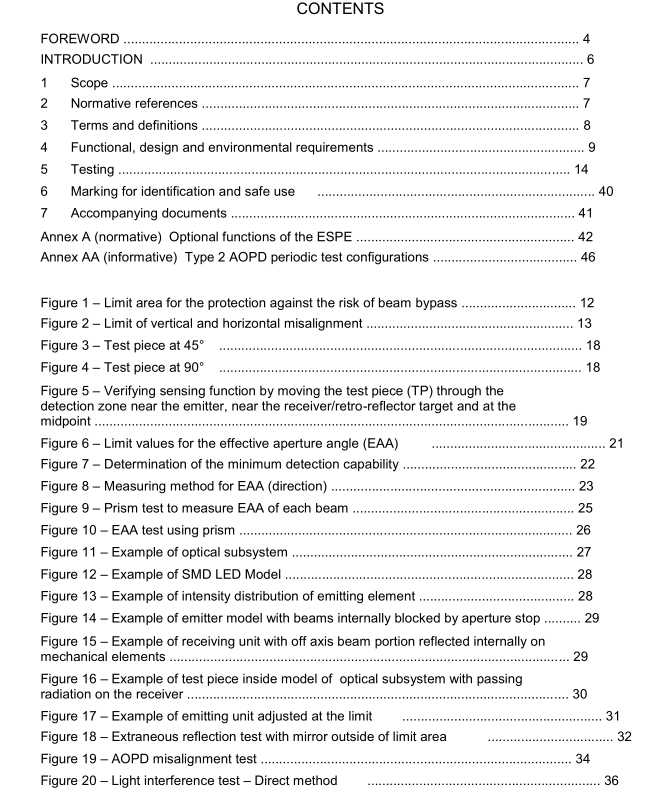IEC 61496-2 pdf – Safety of machinery – Electro-sensitive protective equipment – Part 2: Particular requirements for equipment using active opto-electronic protective devices (AOPDs)

IEC 61496-2 pdf – Safety of machinery – Electro-sensitive protective equipment – Part 2: Particular requirements for equipment using active opto-electronic protective devices (AOPDs)
4.1.2.2
Additional requirements for AOPDs using retro-reflective techniques and forAOPDs using mixed emitters and receivers in the same assembly
4.1.2.2.1
General
AOPDs using retro-reflective techniques where the light beam traverses the detection zonemore than once (over the same path) and AOPDs using mixed emitters and receivers in thesame assembly shall not fail to danger if a reflective object (for example, reflective clothes) is
placed at any position in the detection zone.
NOTE The use of mirrors to return the light beam is not considered to be a retro-reflectivetechnique.4.1.2.2.2Sensing function
The OSSD(s) shall go to the OFF-state when a reflective object of a size equal to, or greaterthan, the diameter and length of the test piece (see 4.2.13) is placed in the detection zone atany position as specified in 5.2.1.4.
For a type 3 AOPD or a type 4 AOPD,under normal operating conditions, the OSSD(s) shallgo to the OFF-state when a reflective object,as specified in 5.2.1.4, is placed as close aspracticable in front of the sensing surface of the emitting/receiving elements.
4.1.3Types of ESPE
Replacement:
ln this document,only type 2, type 3 and type 4 ESPEs are considered. The types differ intheir performance in the presence of faults and under influences from environmentalconditions. ln IEC 61496-1:2020, the effects of electrical and electromechanical faults areconsidered (such faults are listed in Annex B of lEC 61496-1:2020).
NOTE The machine supplier andlor the user will determine which type is required for a particular application.
For a type 2 ESPE, in normal operation the output circuit of at least one output signalswitching device shall go to the OFF-state when the sensing function is actuated,or whenpower is removed from the ESPE.
A type 2 ESPE shall fulfil the fault detection requirements of 4.2.2.3.Atype 3 ESPE shall fulfil the fault detection requirements of 4.2.2.4.
A type 4 ESPE shall fulfil the fault detection requirements of 4.2.2.5.
For a type 3 or a type 4 ESPE, in normal operation the output circuit of at least two outputsignal switching devices shall go to the OFF-state when the sensing function is actuated,orwhen power is removed from the ESPE.
When a single safety-related data interface is used to perform the functions of the osSD(s),the data interface and associated safety-related communication interface shall meet therequirements of 4.2.4.4 of IEC 61496-1:2020. In this case,a single safety-related datainterface can substitute for two ossDs in a type 3 ESPE or a type 4 ESPE.
4.2Design requirements
4.2.2Fault detection requirements
4.2.2.3Particular requirements for a type 2 ESPEAddition:
The periodic test shall verify that each light beam operates in the manner specified by thesupplier.
Different configurations are considered that differ in the way the testing of the safety relatedperformance is carried out.
Annex AA,Figure AA.1,Figure AA.2 and Figure AA.3 are examples of type 2 AOPDs wherethe periodic test is externally initiated and the results are externally evaluated. Annex AA,Figure AA.4 is an example of a type 2AOPD where the periodic test is automatically initiated
and evaluated internally.
Replacement:
4.2.12Integrity of the AOPD detection capability
The design of the AOPD shall be such that the AOPD detection capability does not changefrom the value stated by the supplier when the AOPD is operated under any and allcombinations of the following:
any condition within the specification of the supplier;- the environmental conditions specified in 4.3;
– at the limits of alignment and/or adjustment;- over the entire detection zone.
lf a single fault (as specified in Annex B of lEC 61496-1:2020), which under normal operating
conditions (see 5.1.2.1) would not result in a loss of AOPD detection capability but,whenoccurring with a combination of the conditions specified above,would result in such a loss,that fault together with that combination of conditions shall be considered as a single fault,and the AOPD shall respond to such a single fault as required in 4.2.2.
The AOPD shall be designed and constructed to:
a) limit the possibility of failure to danger resulting from extraneous reflections (for operatingrange up to 3 m, see Figure 1);
b) limit the misalignment at which normal operation is possible.For an operating range of 3 m the limits of Figure 2 shall be met;
c) limit the possibilityof malfunction during exposure to extraneous light in the range of400 nm to 1 500 nm.









